Griffiths D. Head First Statistics
Подождите немного. Документ загружается.


you are here 4 391
Now let’s try using the normal approximation to the binomial and check that we get the same
result. First of all, if X ~ B(12, 0.5), what normal distribution can we use to approximate this?
Once you’ve found that, what’s P(X < 6)?

392 WHO WANTS TO WIN A SWIVEL CHAIR
To find individual probabilities, we use the formula
P(X = r) =
n
C
r
p
r
q
n-r
where
We need to find P(X < 6) where X ~ B(12, 0.5). To do this, we need to find
P(X = 0) through P(X = 5), and then add all the probabilities together.
The individual probabilities are
n
C
r
= n!
r!(n - r)!
P(X = 0) =
12
C
0
x 0.5
12
= 0.5
12
P(X = 1) =
12
C
1
x 0.5 x 0.5
11
= 12 x 0.5
12
P(X = 2) =
12
C
2
x 0.5
2
x 0.5
10
= 66 x 0.5
12
P(X = 3) =
12
C
3
x 0.5
3
x 0.5
9
= 220 x 0.5
12
P(X = 4) =
12
C
4
x 0.5
4
x 0.5
8
= 495 x 0.5
12
P(X = 5) =
12
C
5
x 0.5
5
x 0.5
7
= 792 x 0.5
12
Adding these together gives us an overall probability of
P(X < 6) = (1 + 12 + 66 + 220 + 495 + 792) x 0.5
12
= 1586 x 0.5
12
= 0.387 (to 3 decimal places)
Before we use the normal distribution for the full 40 questions for Who Wants To Win A Swivel
Chair, let’s tackle a simpler problem to make sure it works. Let’s try finding the probability that
we get 5 or fewer questions correct out of 12, where there are only two possible choices for
each question.
Let’s start off by working this out using the binomial distribution. Use the binomial distribution
to find P(X < 6) where X ~ B(12, 0.5).

you are here 4 393
What do you think could have gone wrong? How
do you think we could fix it?
Did I miss something?
In what way was that a
good approximation?
The two methods of calculating the probability have given
quite different results.
Using the binomial distribution, P(X < 6) comes to 0.387, but using the normal
distribution it comes to 0.5. We should have been able to use the normal
distribution in place of the binomial, but the results aren’t close enough.
Now let’s try using the normal approximation to the binomial and check we get the same result.
First of all, if X ~ B(12, 0.5), what normal distribution can we use to approximate this? Once
you’ve found that, what’s P(X < 6)?
X ~ B(12, 0.5), which means that n = 12, p = 0.5 and q = 0.5. A good approximation to this is
X ~ N(np, npq), or X ~ N(6, 3).
We want to find P(X < 6), so we start by calculating the standard score.
z = x - μ
σ
= 6 - 6
3
= 0
Looking this up in probability tables gives us
P(X < 6) = 0.5
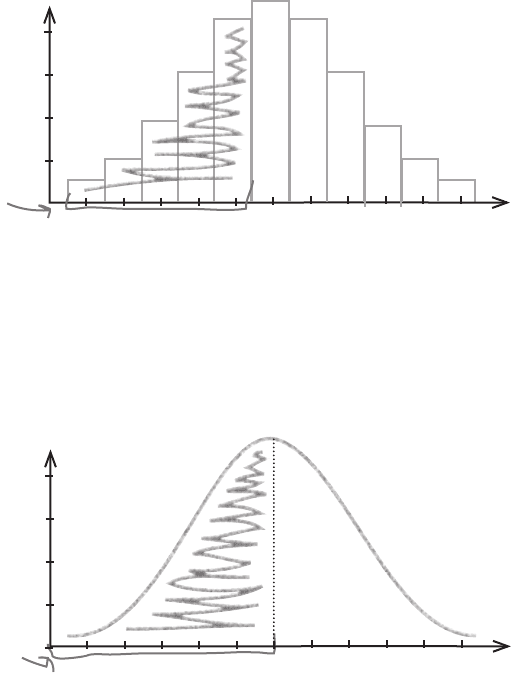
394 WHO WANTS TO WIN A SWIVEL CHAIR
Revisiting the normal approximation
So what went wrong? Let’s take a closer look at the problem and see if we can
figure out what happened and also what we can do about it.
First off, here’s the probability distribution for X ~ B(12, 0.5). We wanted to find
the probability of getting fewer than 6 questions correct, and we achieved this by
calculating P(X < 6).
We then approximated the distribution by using X ~ N(6, 3), and as needed to find
P(X < 6) for the binomial distribution, we calculated P(X < 6) using the normal
distribution:
Take a really close look at the two probability distributions. It’s tricky to spot, but
there’s a crucial difference between the two—the ranges we used to calculate the
two probabilities are slightly different. We actually used a slightly larger range when
we used the normal distribution, and this accounts for the larger probability.
We’ll look at this in more detail on the next page.
11
P(X < 6) is this area here.
0.1
0.5
0.15
1 2 3 4 5
6
0.20
7 8 9 10 11
0.1
0.5
0.15
1 2 3 4 5
6
0.20
7 8 9 10
We found P(X < 6)
by adding all these
together.
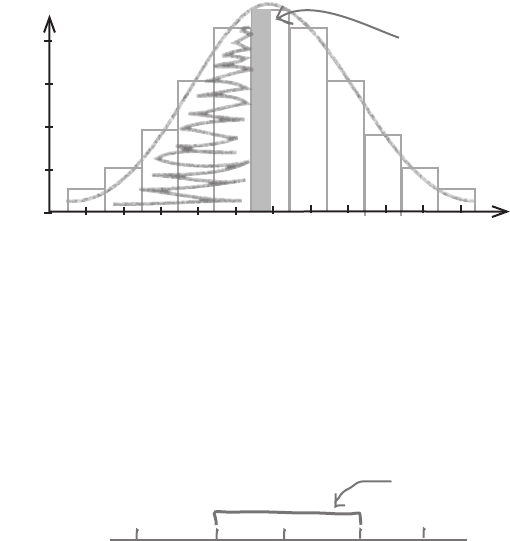
you are here 4 395
5 5.5 6 6.5 7
Can you see where the problem lies?
When we take integers from a discrete probability distribution and translate them onto a
continuous scale, we don’t just look at those precise values in isolation. Instead, we look
at the range of numbers that round to each of the values.
Let’s take the discrete value 6 as an example. When we translate the number 6 to a
continuous scale, we need to consider all of the numbers that round to it—in other
words, the entire range of numbers from 5.5 to 6.5.
There’s one thing we overlooked when we calculated the two probabilities—we didn’t
make allowances for one distribution being discrete (the binomial), and the other being
continuous (the normal). This is important, as the probability range we use can make a
big difference to the resulting probabilities.
Here are the probability distributions for X ~ B(12, 0.5) and N(6, 3), both shown on the
same chart. We’ve highlighted where the probability range we used with the normal
distribution extends beyond the range we used for the binomial distribution.
All of these
values round to 6.
So how does this apply to our probability problem?
When we tried using the normal distribution to approximate the probability of getting
fewer than 6 questions correct, we didn’t look at how the discrete value 6 translates onto a
continuous scale. The discrete value 6 actually covers a range from 5.5 to 6.5, so instead of
using the normal distribution to find P(X < 6), we should have tried calculating
P(X < 5.5) instead.
This adjustment is called a continuity correction. A continuity correction is the small
adjustment that needs to be made when you translate discrete values onto a continuous scale.
The binomial is discrete, but the normal is continuous
We didn’t include this area when we calculated
P(X < 6) using the binomial distribution, but we
did when we calculated P(X < 6) using the normal
distribution.
0.1
0.5
0.15
1 2 3 4 5
6
0.20
7 8 9 10 11

396 WHO WANTS TO WIN A SWIVEL CHAIR
Let’s try finding P(X < 5.5) where X ~ N(6, 3), and see how good an approximation
this is for the probability of getting five or fewer questions correct. Using the binomial
distribution we found that the probability we’re aiming for is around 0.387.
Let’s see how close an approximation the normal distribution gives us.
We want to find P(X < 5.5) where X ~ (6, 3), so let’s start by calculating the standard score.
z = x - μ
σ
= 5.5 - 6
3
= -0.29 (to 2 decimal places)
We want to find the probability given by the area Z < -0.29, and looking this up in
standard normal probability tables gives us a probability of 0.3859. In other words,
P(X < 5.5) = 0.3859
This is really close to the probability we came up with using the binomial distribution. The
binomial distribution gave us a probability of 0.387, so the normal distribution gives us a
pretty close approximation.
In particular circumstances you can
use the normal distribution to
approximate the binomial. If
X ~ B(n, p) and np > 5 and nq > 5
then you can approximate X using
X ~ N(np, npq)
If you’re approximating the binomial
distribution with the normal
distribution, then you need to apply a
continuity correction to make sure
your results are accurate.
Look at these two
probabilities. They’re
really close, so it looks
like the continuity
correction did the trick.
Apply a continuity correction before calculating the approximation
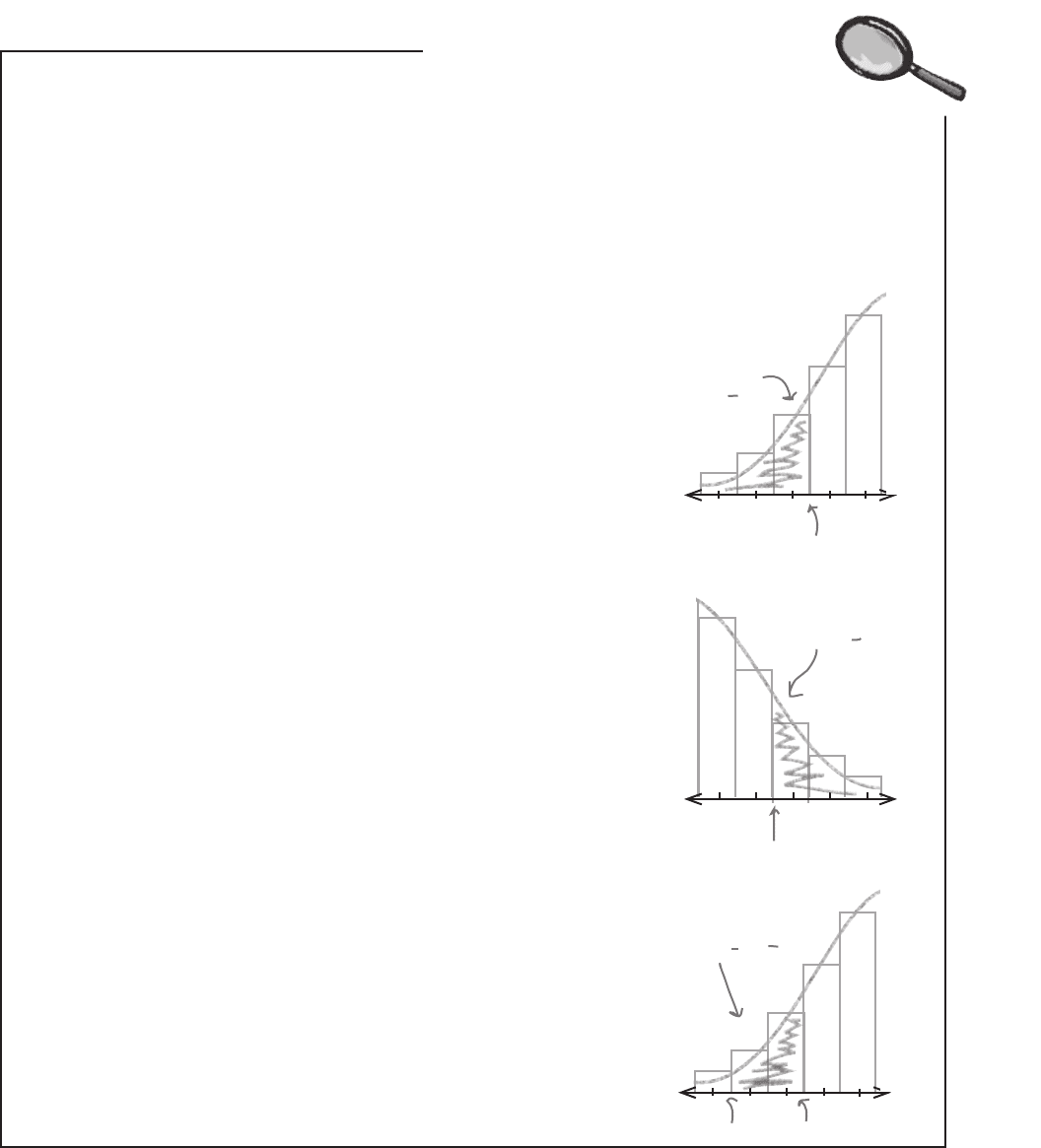
you are here 4 397
You need to use
P(X < 3.5) to
approximate
P(X < 3).
1 2 3 4
5
1 2 3 4
5
1.5
3.5
The big trick with using the normal distribution to approximate binomial probabilities
is to make sure you apply the right continuity correction. As you’ve seen, small
changes in the probability range you choose can lead to significant errors in the actual
probabilities. This might not sound like too big a deal, but using the wrong probability
could lead to you making the wrong decisions.
Let’s take a look at the kinds of continuity corrections you need to make for different
types of probability problems.
Finding ≤ probabilities
When you work with probabilities of the form P(X ≤ a), the key thing you
need to make sure of is that you choose your range so that it includes the
discrete value a. On a continuous scale, the discrete value a goes up to
(a + 0.5). This means that if you’re using the normal distribution to find
P(X ≤ a), you actually need to calculate P(X < a + 0.5) to come up with a
good approximation. In other words, you add an extra 0.5.
Finding “between” probabilities
Probabilities of the form P(a ≤ X ≤ b) need continuity corrections to make
sure that both a and b are included. To do this, we need to extend the range
out by 0.5 either side. To approximate this probability using the normal
distribution, we need to find P(a - 0.5 < X < b + 0.5). This is really just a
combination of the two types above.
3.5
7 8 9 10 11
8.5
Finding ≥ probabilities
If you need to find probabilities of the form P(X ≥ b), you need to make
absolutely sure that your range includes the discrete value b. The value b
extends down to (b - 0.5) on a continuous scale so you need to use a range of
P(X > b - 0.5) to make sure that you include it. In other words, you need to
subtract an extra 0.5.
This time, we subtract
0.5 and use P(X > 8.5)
to find P(X > 9).
We use P(1.5 < X < 3.5)
to find P(2 < X < 3).
Continuity Corrections Up Close

398 WHO WANTS TO WIN A SWIVEL CHAIR
Q:
Does it really save time to
approximate the binomial distribution
with the normal?
A: It can save a lot of time. Calculating
binomial probabilities can be time-consuming
because you generally have to work out the
probability of lots of different values. You
have no way of simply calculating binomial
probabilities over a range of values.
If you approximate the binomial distribution
with the normal distribution, then it’s a lot
quicker. You can look probabilities up in
standard tables and also deal with whole
ranges at once.
Q:
So is it really accurate?
A:Yes, It’s accurate enough for most
purposes. The key thing to remember is that
you need to apply a continuity correction.
If you don’t then your results will be less
accurate.
Q:
What about continuity corrections
for < and >? Do I treat those the same
way as the ones for ≤ and ≥?
A: There’s a difference, and it all comes
down to which values you want to include
and exclude.
When you’re working out probabilities using
≤ and ≥, you need to make sure that you
include the value in the inequality in your
probability range. So if, say, you need to
work out P(X ≤ 10), you need to make sure
your probability includes the value 10. This
means you need to consider P(X < 10.5).
When you’re working out probabilities using
< or >, you need to make sure that you
exclude the value in the inequality from your
probability range. This means that if you
need to work out P(X < 10), you need to
make sure that your probability excludes 10.
You need to consider P(X < 9.5).
Q:
You can approximate the binomial
distribution with both the normal and
Poisson distributions. Which should I
use?
A: It all depends on your circumstances.
If X ~ B(n, p), then you can use the normal
distribution to approximate the binomial
distribution if np > 5 and nq > 5.
You can use the Poisson distribution to
approximate the binomial distribution if
n > 50 and p < 0.1
Remember, you need to apply a continuity correction when you
approximate the binomial distribution with the normal distribution.
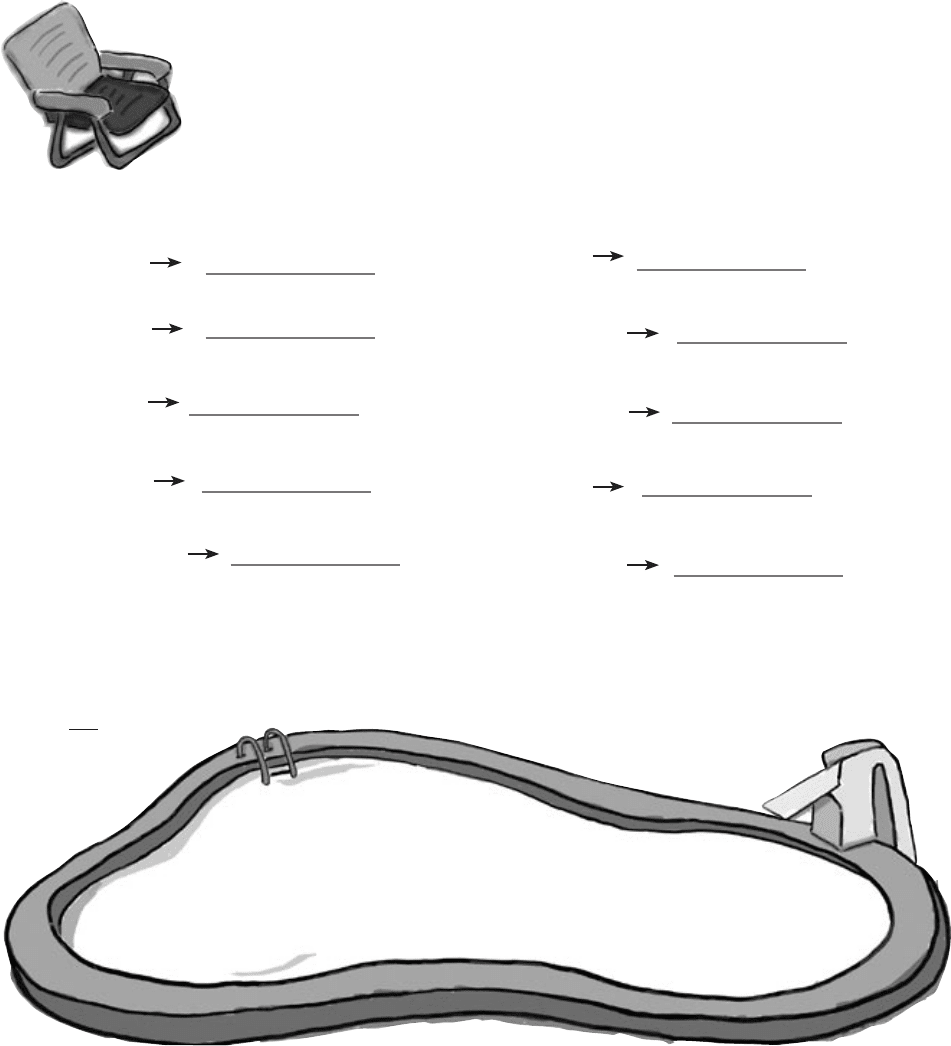
you are here 4 399
Pool Puzzle
Your job is to take snippets from the
pool and place them into the blank
lines so that you get the right
continuity correction for each
dscrete probability range. You
may use the same snippet more
than once, and you won’t need to
use all the snippets.
Note: each thing from
the pool can be used
more than once!
X < 3
X > 3
X ≥ 3
X ≤ 3
X > 0
X = 0
3 ≤ X ≤ 10
3 < X ≤ 10
3 ≤ X < 10
3 < X < 10
X
X
X
X
X
X
X
X
X
X
<
>
2.5
2.5
10.5
9.5
0.5
-
0.5
0
3.5
10.5
0.5
0
2.5
9.5
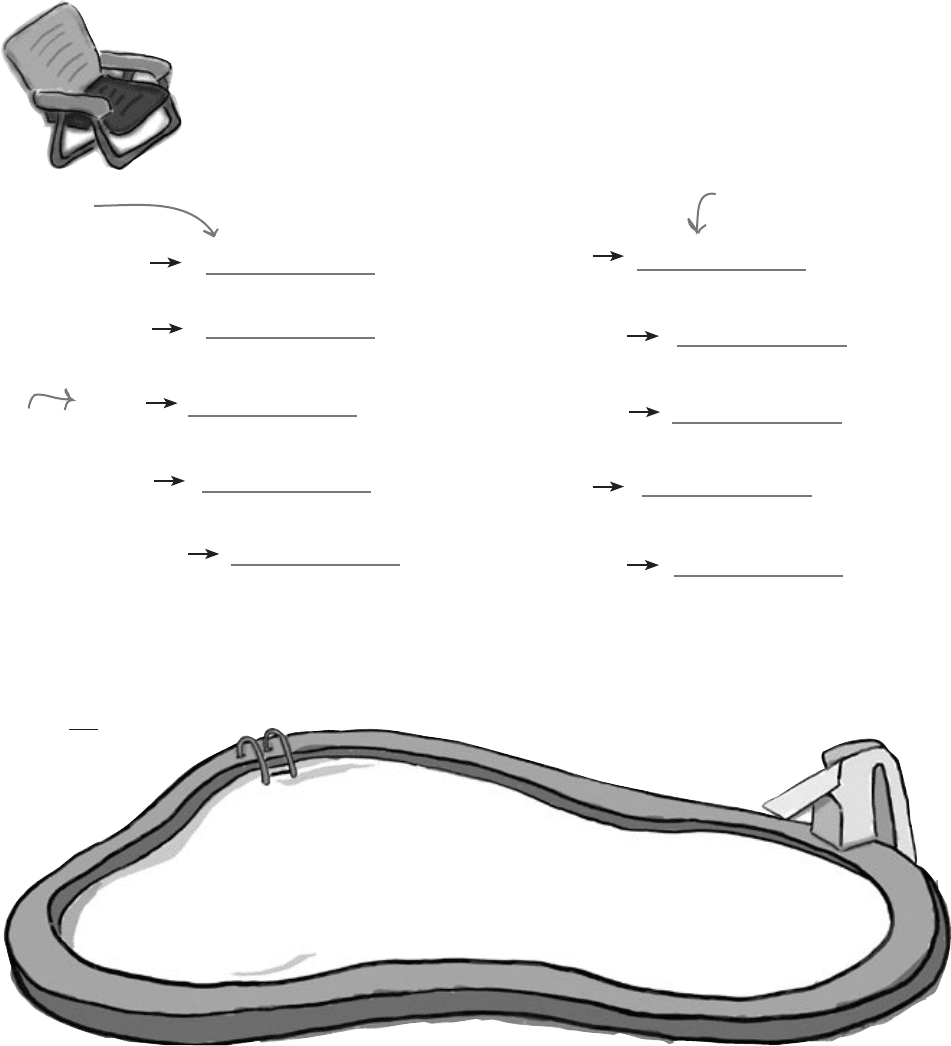
400 WHO WANTS TO WIN A SWIVEL CHAIR
<
Pool Puzzle
Your job is to take snippets from the
pool and place them into the blank
lines so that you get the right
continuity correction for each
dscrete probability range. You
may use the same snippet more
than once, and you won’t need to
use all the snippets.
Note: each thing from
the pool can be used
more than once!
X < 3
X > 3
X ≥ 3
X ≤ 3
X > 0
X = 0
3 ≤ X ≤ 10
3 < X ≤ 10
3 ≤ X < 10
3 < X < 10
X
X
X
X
X
X
X
X
X
<
<
<
<
<
<
< <
<
<
>
>
>
2.5
3.5
2.5
2.5
3.5
9.5
0.5-
0.5
3.5
2.5
10.5
0.5
0
3.5
9.5
All the numbers from -0.5
to 0.5 round to 0, so they
must be included in the
range.
Here, we’re looking
for values less than
3. 2.5 rounds to 3,
so we only want to
include values less
than 2.5 in
our range.
Here, we’re looking
for values less
than or equal to
3. All the numbers
between 2.5 and
3.5 round to 3, so
we need to include
values less than
3.5 in our range.
< 10.5X
